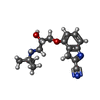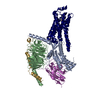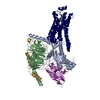+Search query
-Structure paper
| Title | Structures of β-adrenergic receptor in complex with Gs and ligands of different efficacies. |
|---|---|
| Journal, issue, pages | Nat Commun, Vol. 13, Issue 1, Page 4095, Year 2022 |
| Publish date | Jul 14, 2022 |
 Authors Authors | Minfei Su / Navid Paknejad / Lan Zhu / Jinan Wang / Hung Nguyen Do / Yinglong Miao / Wei Liu / Richard K Hite / Xin-Yun Huang /  |
| PubMed Abstract | G-protein-coupled receptors (GPCRs) receive signals from ligands with different efficacies, and transduce to heterotrimeric G-proteins to generate different degrees of physiological responses. ...G-protein-coupled receptors (GPCRs) receive signals from ligands with different efficacies, and transduce to heterotrimeric G-proteins to generate different degrees of physiological responses. Previous studies revealed how ligands with different efficacies activate GPCRs. Here, we investigate how a GPCR activates G-proteins upon binding ligands with different efficacies. We report the cryo-EM structures of β-adrenergic receptor (β-AR) in complex with Gs (GαGβGγ) and a partial agonist or a very weak partial agonist, and compare them to the β-AR-Gs structure in complex with a full agonist. Analyses reveal similar overall complex architecture, with local conformational differences. Cellular functional studies with mutations of β-AR residues show effects on the cellular signaling from β-AR to the cAMP response initiated by the three different ligands, with residue-specific functional differences. Biochemical investigations uncover that the intermediate state complex comprising β-AR and nucleotide-free Gs is more stable when binding a full agonist than a partial agonist. Molecular dynamics simulations support the local conformational flexibilities and different stabilities among the three complexes. These data provide insights into the ligand efficacy in the activation of GPCRs and G-proteins. |
 External links External links |  Nat Commun / Nat Commun /  PubMed:35835792 / PubMed:35835792 /  PubMed Central PubMed Central |
| Methods | EM (single particle) |
| Resolution | 2.5 - 2.6 Å |
| Structure data | EMDB-27328, PDB-8dcr: EMDB-27329, PDB-8dcs: |
| Chemicals |  ChemComp-Y00:  ChemComp-P32: |
| Source |
|
 Keywords Keywords | SIGNALING PROTEIN / beta1-adrenergic receptor / dobutamine / partial agonist / cyanopindolol |
 Movie
Movie Controller
Controller Structure viewers
Structure viewers About Yorodumi Papers
About Yorodumi Papers









